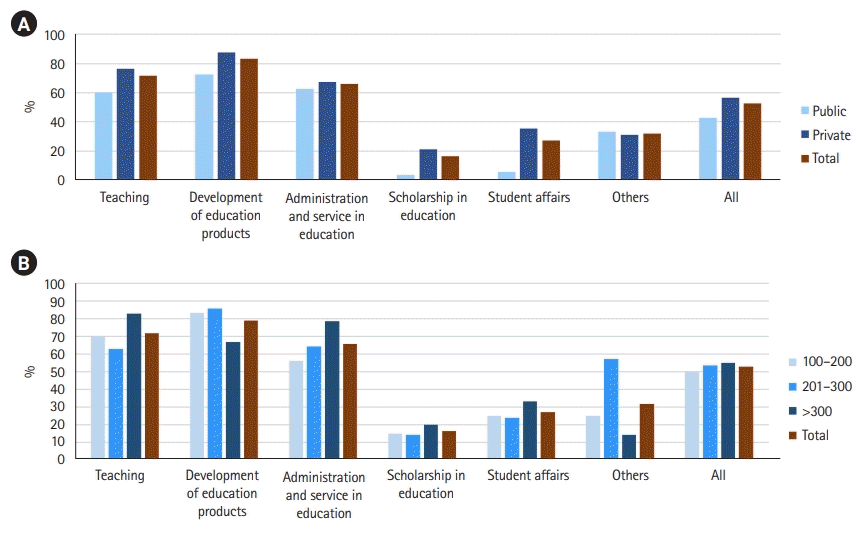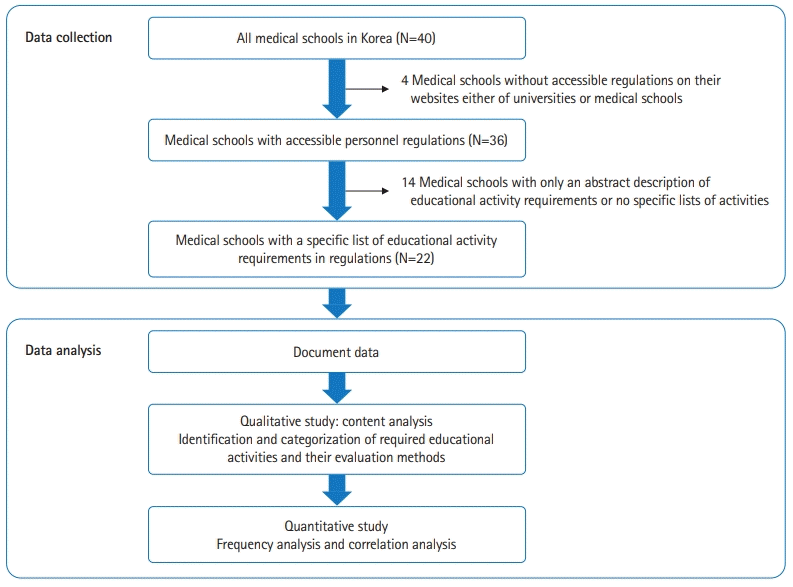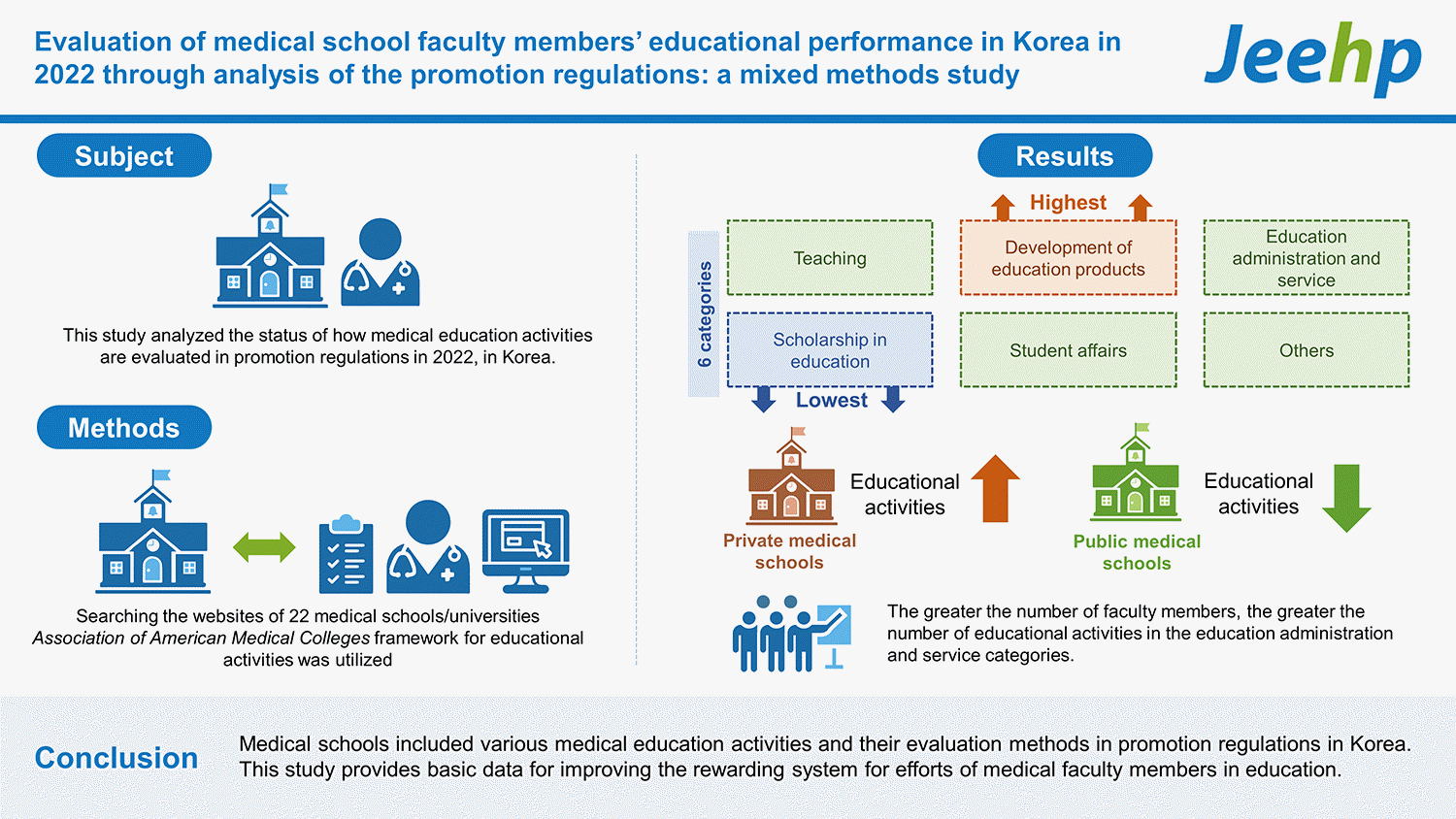|
Teaching |
3.6/5 (71.8) |
T1. Lecture activities |
95.5 (21/22) |
● Lecturing in preclinical, clinical, or graduate courses |
● Lecturing in a pre-med course |
|
● Lecturing during grand rounds |
● Lecturing in a selective course |
|
● Lecturing in an integrative course |
|
● Lecturing in an English class |
|
|
T2. Laboratory activities |
40.9 (9/22) |
● Providing instruction in wet laboratory, computer laboratory, or skills laboratory activities |
● Instruction in a wet laboratory |
|
● Providing instruction in research laboratory work |
● Instruction in clinical skill lab (ICM) |
|
|
T3. Small-group activities (non-clinical) |
77.3 (17/22) |
● Serving as a tutor or facilitator in problem-based learning |
● Tutor in problem-based learning |
|
● Serving as a small-group leader in a course |
● Facilitator in team-based learning |
|
● Serving as a seminar leader |
● Moderator/commentator of small-group discussion |
|
● Leading a seminar for graduate students |
|
|
T4. Individual activities (non-clinical) |
90.9 (20/22) |
● Serving as an individual tutor |
● Mentor for academic underachievers |
|
● Serving as an advisor or mentor for students and trainees |
● Research preceptor of medical students’ scholarly project |
|
● Serving as a research preceptor or thesis director |
● Advisor of master’s degree students |
|
● Giving assistance with grant or manuscript preparation |
● Member of doctoral review committee |
|
|
T5. Clinical activities |
54.5 (12/22) |
● Performing inpatient teaching during attending rounds |
● Teaching during a clinical clerkship |
|
● Teaching in surgery or special clinical procedure rooms |
● Conducting bedside teaching |
|
● Serving as preceptor for the student–house-staff patient care team |
● Teaching in surgery rooms |
|
● Serving as an outpatient clinic attending |
● Teaching in outpatient clinic |
|
● Serving as a case-based session leader on wards or in clinic |
● Managing the students’ schedule |
|
● Participating in a mini-OSCE |
|
● Leading a case-based discussion |
|
Development of educational products |
2.4/3 (78.8) |
D1. Development of educational units |
63.6 (14/22) |
● Developing a major curricular unit (e.g., course, clerkship, or laboratory program) |
● Participating in major revision of the course |
|
● Developing a minor curricular unit (e.g., lab session, problem-based learning case, or conference) |
● Developing a PBL module |
|
● Participating in a major revision of course, clerkship, laboratory, or other units |
● Developing a CPX module, standardized patient scenario, checklist |
|
|
D2. Development of educational materials |
77.2 (17/22) |
● Developing innovative teaching methods, learning tools, or distance learning |
● Developing the e-learning content |
|
● Developing a syllabus or manual (e.g., course or laboratory) |
● Developing the test items (including KMLE, consortium test) |
|
● Developing teaching materials |
|
|
● Developing examinations and other evaluation tools |
|
|
|
D3. Development of personnel |
95.5 (21/22) |
● Participating in standardized patient orientation and training |
● Participating in an internal/external faculty program |
|
● Developing faculty members and staff skills |
● Participating in a workshop for newly recruited faculty members |
|
Education administration and service |
2.6//4 (65.9) |
A1. Direction of educational components |
95.5 (21/22) |
● Serving as a program director (e.g., directing graduate or residency program) |
● Director of graduate common course |
|
● Serving as a course director |
● Course/clerkship director |
|
● Serving as a clerkship director |
● Elective director (e.g., research, preclinical, clinical) |
|
● Serving as a laboratory director |
● Director of review activities for certification examinations |
|
● Serving as an elective director (e.g., research, preclinical, clinical) |
● Advisor/mentor of a club/grade |
|
● Serving as a director of review activities for certification examinations |
|
|
● Serving as a student affairs director |
|
|
|
A2. Evaluation of education |
68.2 (15/22) |
● Evaluating student, resident, or other trainee performance |
● Evaluator of CPX, KMLE, portfolios |
|
● Evaluating major curriculum change |
● Examination supervisor |
|
● Evaluating education programs |
● Writing a self-evaluation report of the medical school |
|
● Participating in preparation of medical school accreditation |
|
|
A3. Administration of education |
59.1 (13/22) |
● Providing leadership at school level (e.g., education dean) |
● Vice dean (education, research, planning) |
|
● Managing course, clerkship, laboratory, conference, or elective activities |
● Head of an office/department of medical education |
|
● Designing and administering training programs, including research training |
● Head of a research center |
|
● Contributing to facilities development and scheduling |
● Chairman or member of an educational committee |
|
● Providing education committee service and leadership |
|
|
|
A4. Special services |
40.9 (9/22) |
● Serving in outreach programs (e.g., K–12, college, community, and government) |
● Teaching other medical professionals, the public, and residents |
|
● Participating in K-MOOC, open campus for high school students |
|
Scholarship in education |
0.8/5 (16.4) |
S1. Research in education |
9.1 (2/22) |
● Submitting an education grant proposal (internal or external) |
● Contribution of an educational project |
|
● Directing educational research or scholarly project (internal or external) |
● Submitting a curriculum research report |
|
|
S2. Presentations in education |
50.0 (11/22) |
● Making internal presentations |
● Presenter at an internal/external faculty members development program (seminar, workshop, etc.) |
|
● Making external keynote, plenary, or symposium lectures or presentations |
● Presenter at an academic annual meeting |
|
● Making external abstract-based oral or poster presentations |
|
|
|
S3. Service on editorial boards, review bodies, or in elected positions |
13.6 (3/22) |
● Serving as a book or journal editor |
● Chair of an editorial board |
|
● Serving as an editorial board member or chair |
● Reviewing manuscripts |
|
● Reviewing manuscripts, media, etc. |
● Reviewing grants |
|
● Reviewing grants |
|
|
● Serving in an elected office in an educational organization |
|
|
● Providing consultations in education |
|
|
|
S4. Receiving education awards and prizes (internal and external) |
9.1 (2/22) |
● Receiving education awards and prizes (internal and external) |
● Best teacher award |
|
● National/public institute/community educational award |
|
Student affairs |
1.2/3 (40.9) |
SA1. Participating in admission |
36.3 (8/22) |
● Participating as an evaluator in the student admission examination |
● Serving as evaluator in admission interview/entrance examination |
|
● developing admission examination items |
● Developing admission interview item |
|
|
SA2. Counseling and mentoring |
59.1 (13/22) |
● Counseling or mentoring students |
● Student counseling |
|
● Career counseling |
|
|
SA3. Supporting extracurricular activities |
27.3 (6/22) |
● Participating in extracurricular activities |
● Participating in graduation trips, field training, orientations, retreats |
|
Others |
0.3/1 (31.8) |
O1. Others |
31.8 (7/22) |
● Others |
● Donation, fundraising, performance of clinical practice in hospital, pass rate of the Korean National Licensing Examination for Physicians, pass rate of specialty examinations, stages of disciplinary action |





 PDF
PDF Citation
Citation Print
Print






 XML Download
XML Download